Business Environment Analysis: British Airways Report, Semester 1
VerifiedAdded on 2019/12/03
|13
|3998
|322
Report
AI Summary
This report provides a comprehensive analysis of the business environment surrounding British Airways (BA). It begins by outlining the purposes of different organizational types and assessing how well BA meets the objectives of its stakeholders, including shareholders, creditors, the government, and customers, while also detailing the company's responsibilities and strategies. The report then delves into economic systems, examining how resources are allocated in free market, mixed, and social economies, followed by an analysis of the impact of monetary and fiscal policies on BA's operations. Furthermore, it explores the influence of competition policies and regulatory mechanisms on the airline. The second part of the report examines market structures affecting BA's pricing and output decisions, highlighting the ways market forces shape organizational responses. It also touches upon the business and cultural environment influencing working practices, before discussing the significance of international trade to BA and the impact of global factors, including the policies of the European Union. The report concludes with a summary of key findings and recommendations for BA.
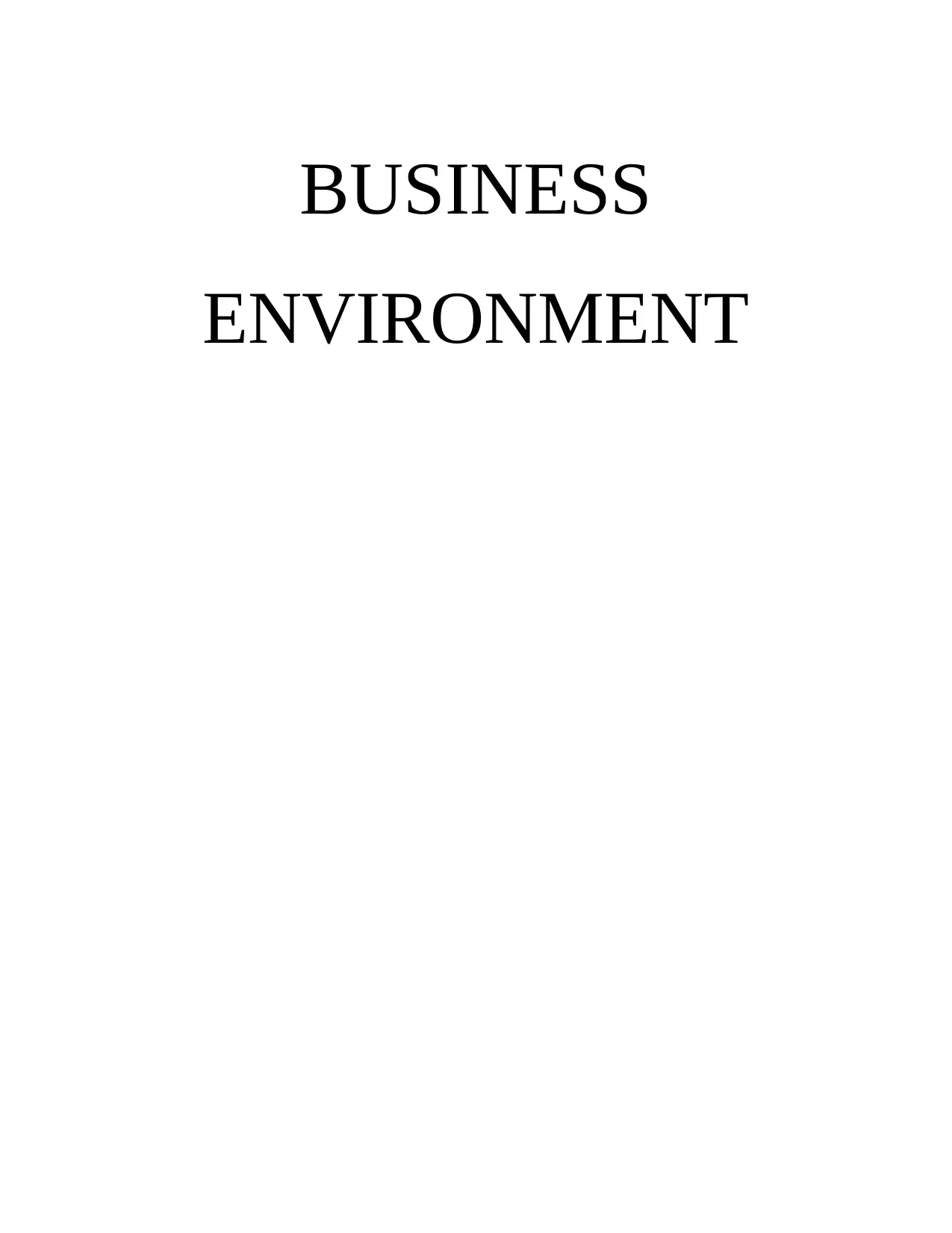
BUSINESS
ENVIRONMENT
ENVIRONMENT
Paraphrase This Document
Need a fresh take? Get an instant paraphrase of this document with our AI Paraphraser

TABLE OF CONTENTS
INTRODUCTION...........................................................................................................................1
TASK 1............................................................................................................................................1
1.1 Purpose of different kinds of organizations......................................................................1
1.2 Extent to which an organization is achieving objectives of its stakeholders...................2
1.3 Responsibilities of an organization and strategies adopted to fulfill them.......................2
2.1 Ways in which economic system allocate resources effectively......................................3
2.2 Impact of monetary and fiscal policy on an organization activities.................................4
2.3 Impact of competition policy and other regulatory mechanisms on British airways.......4
TASK 2............................................................................................................................................5
3.1 Market structures affecting pricing and output decisions for BA....................................5
3.2 Different ways in which market forces shape organizational responses..........................6
3.3 Business and cultural environment influencing working practice...................................6
4.1 Significance of international trade to British Airways.....................................................7
4.2 Impact of global factors on BA........................................................................................8
4.3 Impact of policies of European Union on UK business organizations.............................8
CONCLUSION................................................................................................................................9
REFERENCES..............................................................................................................................10
INTRODUCTION...........................................................................................................................1
TASK 1............................................................................................................................................1
1.1 Purpose of different kinds of organizations......................................................................1
1.2 Extent to which an organization is achieving objectives of its stakeholders...................2
1.3 Responsibilities of an organization and strategies adopted to fulfill them.......................2
2.1 Ways in which economic system allocate resources effectively......................................3
2.2 Impact of monetary and fiscal policy on an organization activities.................................4
2.3 Impact of competition policy and other regulatory mechanisms on British airways.......4
TASK 2............................................................................................................................................5
3.1 Market structures affecting pricing and output decisions for BA....................................5
3.2 Different ways in which market forces shape organizational responses..........................6
3.3 Business and cultural environment influencing working practice...................................6
4.1 Significance of international trade to British Airways.....................................................7
4.2 Impact of global factors on BA........................................................................................8
4.3 Impact of policies of European Union on UK business organizations.............................8
CONCLUSION................................................................................................................................9
REFERENCES..............................................................................................................................10
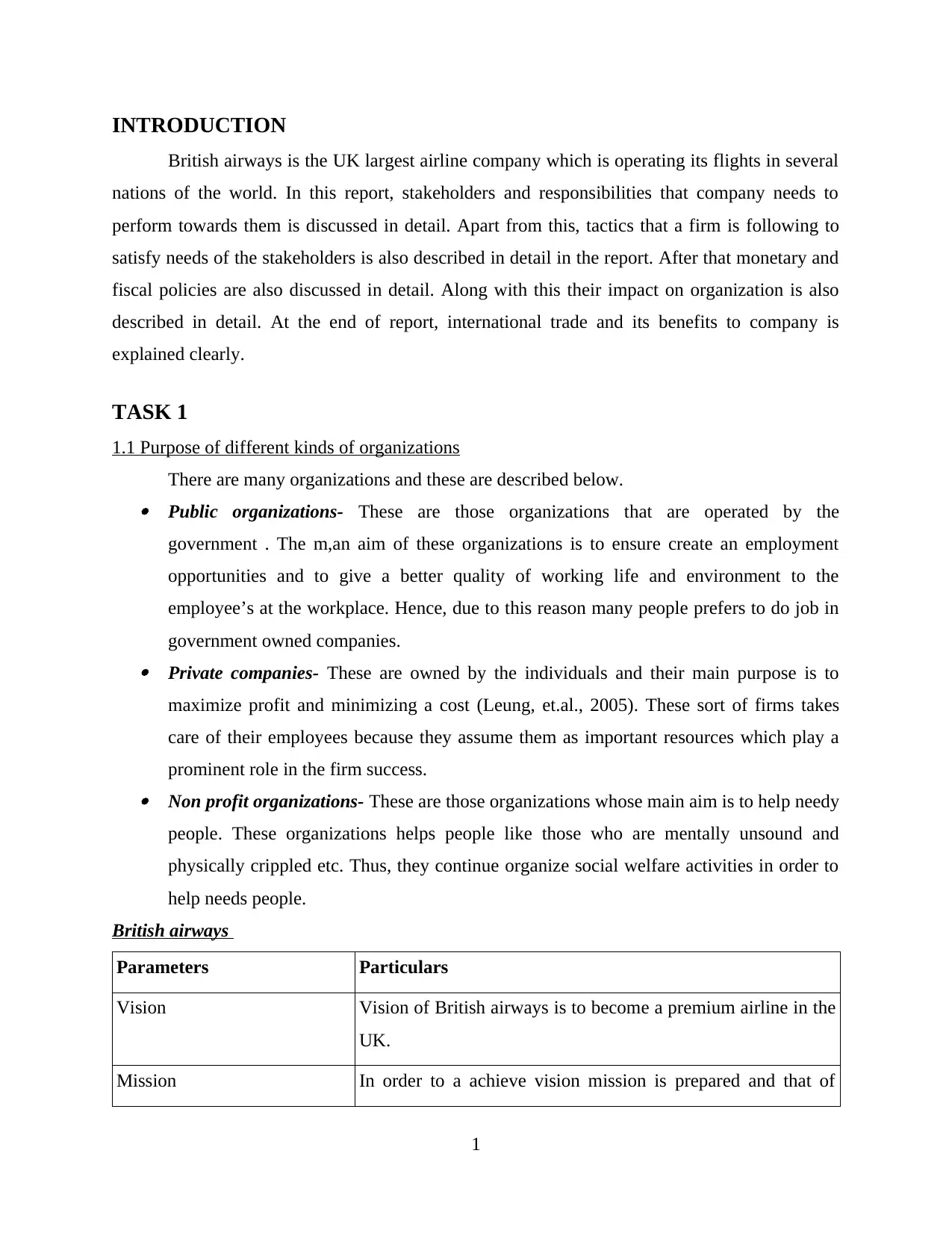
INTRODUCTION
British airways is the UK largest airline company which is operating its flights in several
nations of the world. In this report, stakeholders and responsibilities that company needs to
perform towards them is discussed in detail. Apart from this, tactics that a firm is following to
satisfy needs of the stakeholders is also described in detail in the report. After that monetary and
fiscal policies are also discussed in detail. Along with this their impact on organization is also
described in detail. At the end of report, international trade and its benefits to company is
explained clearly.
TASK 1
1.1 Purpose of different kinds of organizations
There are many organizations and these are described below. Public organizations- These are those organizations that are operated by the
government . The m,an aim of these organizations is to ensure create an employment
opportunities and to give a better quality of working life and environment to the
employee’s at the workplace. Hence, due to this reason many people prefers to do job in
government owned companies. Private companies- These are owned by the individuals and their main purpose is to
maximize profit and minimizing a cost (Leung, et.al., 2005). These sort of firms takes
care of their employees because they assume them as important resources which play a
prominent role in the firm success. Non profit organizations- These are those organizations whose main aim is to help needy
people. These organizations helps people like those who are mentally unsound and
physically crippled etc. Thus, they continue organize social welfare activities in order to
help needs people.
British airways
Parameters Particulars
Vision Vision of British airways is to become a premium airline in the
UK.
Mission In order to a achieve vision mission is prepared and that of
1
British airways is the UK largest airline company which is operating its flights in several
nations of the world. In this report, stakeholders and responsibilities that company needs to
perform towards them is discussed in detail. Apart from this, tactics that a firm is following to
satisfy needs of the stakeholders is also described in detail in the report. After that monetary and
fiscal policies are also discussed in detail. Along with this their impact on organization is also
described in detail. At the end of report, international trade and its benefits to company is
explained clearly.
TASK 1
1.1 Purpose of different kinds of organizations
There are many organizations and these are described below. Public organizations- These are those organizations that are operated by the
government . The m,an aim of these organizations is to ensure create an employment
opportunities and to give a better quality of working life and environment to the
employee’s at the workplace. Hence, due to this reason many people prefers to do job in
government owned companies. Private companies- These are owned by the individuals and their main purpose is to
maximize profit and minimizing a cost (Leung, et.al., 2005). These sort of firms takes
care of their employees because they assume them as important resources which play a
prominent role in the firm success. Non profit organizations- These are those organizations whose main aim is to help needy
people. These organizations helps people like those who are mentally unsound and
physically crippled etc. Thus, they continue organize social welfare activities in order to
help needs people.
British airways
Parameters Particulars
Vision Vision of British airways is to become a premium airline in the
UK.
Mission In order to a achieve vision mission is prepared and that of
1
⊘ This is a preview!⊘
Do you want full access?
Subscribe today to unlock all pages.

Trusted by 1+ million students worldwide

British airways is to bring innovation in the technology.
Objectives In order to achieve vision and mission an objective is prepared.
Objective of British airways is to create an environment
friendly image. In this regard firm will innovate its technology.
This will help firm in achieving its mission.
Short term objectives Short term objective of the firm is to create its environment
friendly image. This image will create a distinct image of the
firm and will justify its premium pricing strategy.
1.2 Extent to which an organization is achieving objectives of its stakeholders
British airways achieving following objectives of its stakeholders.
Shareholders- The main objective of the shareholders is that they get good return on the
investment and firm in which they makes investment have transparent system. British
airways is earning good profit and its corporate governance is also good. Hence, it is
achieving objectives of its shareholders. Creditors- Firm is taking debt from banks and business friends. Creditors always desired
that they receive debt on time (Leung, et.al., 2005). British airways is using a cash
management strategy in order to ensure that timely payment is made to the creditors.
Thus, in this way firm is achieving objectives of its stakeholders. Government- Objective of government is to receive tax on time and at accurate value.
British airways does not face any allegations regarding irregularity in tax payment.
Hence, it is achieving objectives of government as its stakeholder.
Customer’s- Objectives of the customer’s is to receive quality service for the payment
they made to the firm (Porter and Kramer, 2011). Over the years company improve its
service quality and provide many new services to the customer’s. Hence, it can be said
that company is achieving objective of its stakeholders.
1.3 Responsibilities of an organization and strategies adopted to fulfill them Shareholders- In order to fulfill responsibilities towards shareholders firm is preparing a
strategies that increase its presence in new routes. Due to this reason firm profitability
increases and it is able to give good returns to the shareholders (Tan and Tan, 2005). In
2
Objectives In order to achieve vision and mission an objective is prepared.
Objective of British airways is to create an environment
friendly image. In this regard firm will innovate its technology.
This will help firm in achieving its mission.
Short term objectives Short term objective of the firm is to create its environment
friendly image. This image will create a distinct image of the
firm and will justify its premium pricing strategy.
1.2 Extent to which an organization is achieving objectives of its stakeholders
British airways achieving following objectives of its stakeholders.
Shareholders- The main objective of the shareholders is that they get good return on the
investment and firm in which they makes investment have transparent system. British
airways is earning good profit and its corporate governance is also good. Hence, it is
achieving objectives of its shareholders. Creditors- Firm is taking debt from banks and business friends. Creditors always desired
that they receive debt on time (Leung, et.al., 2005). British airways is using a cash
management strategy in order to ensure that timely payment is made to the creditors.
Thus, in this way firm is achieving objectives of its stakeholders. Government- Objective of government is to receive tax on time and at accurate value.
British airways does not face any allegations regarding irregularity in tax payment.
Hence, it is achieving objectives of government as its stakeholder.
Customer’s- Objectives of the customer’s is to receive quality service for the payment
they made to the firm (Porter and Kramer, 2011). Over the years company improve its
service quality and provide many new services to the customer’s. Hence, it can be said
that company is achieving objective of its stakeholders.
1.3 Responsibilities of an organization and strategies adopted to fulfill them Shareholders- In order to fulfill responsibilities towards shareholders firm is preparing a
strategies that increase its presence in new routes. Due to this reason firm profitability
increases and it is able to give good returns to the shareholders (Tan and Tan, 2005). In
2
Paraphrase This Document
Need a fresh take? Get an instant paraphrase of this document with our AI Paraphraser
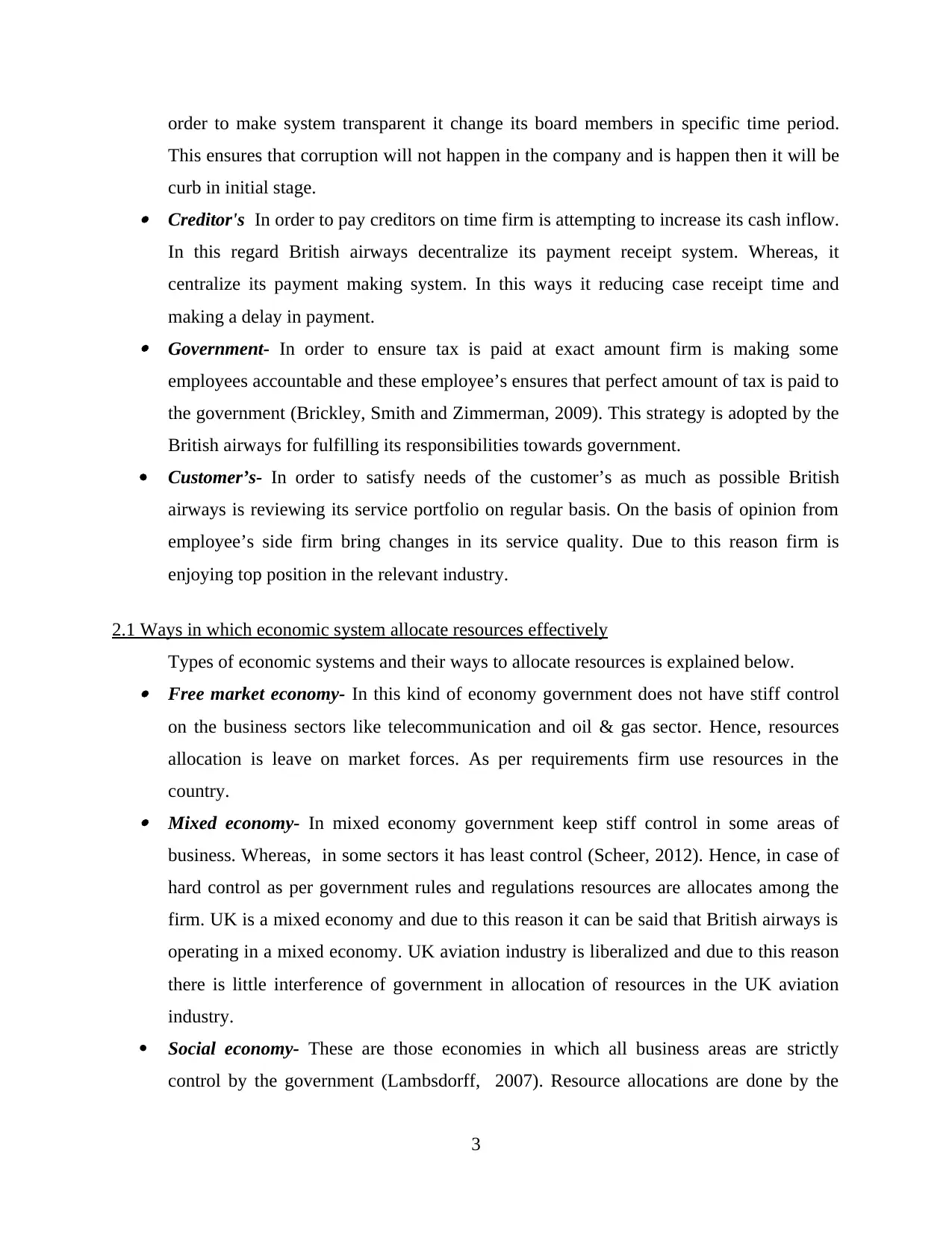
order to make system transparent it change its board members in specific time period.
This ensures that corruption will not happen in the company and is happen then it will be
curb in initial stage. Creditor's In order to pay creditors on time firm is attempting to increase its cash inflow.
In this regard British airways decentralize its payment receipt system. Whereas, it
centralize its payment making system. In this ways it reducing case receipt time and
making a delay in payment. Government- In order to ensure tax is paid at exact amount firm is making some
employees accountable and these employee’s ensures that perfect amount of tax is paid to
the government (Brickley, Smith and Zimmerman, 2009). This strategy is adopted by the
British airways for fulfilling its responsibilities towards government.
Customer’s- In order to satisfy needs of the customer’s as much as possible British
airways is reviewing its service portfolio on regular basis. On the basis of opinion from
employee’s side firm bring changes in its service quality. Due to this reason firm is
enjoying top position in the relevant industry.
2.1 Ways in which economic system allocate resources effectively
Types of economic systems and their ways to allocate resources is explained below. Free market economy- In this kind of economy government does not have stiff control
on the business sectors like telecommunication and oil & gas sector. Hence, resources
allocation is leave on market forces. As per requirements firm use resources in the
country. Mixed economy- In mixed economy government keep stiff control in some areas of
business. Whereas, in some sectors it has least control (Scheer, 2012). Hence, in case of
hard control as per government rules and regulations resources are allocates among the
firm. UK is a mixed economy and due to this reason it can be said that British airways is
operating in a mixed economy. UK aviation industry is liberalized and due to this reason
there is little interference of government in allocation of resources in the UK aviation
industry.
Social economy- These are those economies in which all business areas are strictly
control by the government (Lambsdorff, 2007). Resource allocations are done by the
3
This ensures that corruption will not happen in the company and is happen then it will be
curb in initial stage. Creditor's In order to pay creditors on time firm is attempting to increase its cash inflow.
In this regard British airways decentralize its payment receipt system. Whereas, it
centralize its payment making system. In this ways it reducing case receipt time and
making a delay in payment. Government- In order to ensure tax is paid at exact amount firm is making some
employees accountable and these employee’s ensures that perfect amount of tax is paid to
the government (Brickley, Smith and Zimmerman, 2009). This strategy is adopted by the
British airways for fulfilling its responsibilities towards government.
Customer’s- In order to satisfy needs of the customer’s as much as possible British
airways is reviewing its service portfolio on regular basis. On the basis of opinion from
employee’s side firm bring changes in its service quality. Due to this reason firm is
enjoying top position in the relevant industry.
2.1 Ways in which economic system allocate resources effectively
Types of economic systems and their ways to allocate resources is explained below. Free market economy- In this kind of economy government does not have stiff control
on the business sectors like telecommunication and oil & gas sector. Hence, resources
allocation is leave on market forces. As per requirements firm use resources in the
country. Mixed economy- In mixed economy government keep stiff control in some areas of
business. Whereas, in some sectors it has least control (Scheer, 2012). Hence, in case of
hard control as per government rules and regulations resources are allocates among the
firm. UK is a mixed economy and due to this reason it can be said that British airways is
operating in a mixed economy. UK aviation industry is liberalized and due to this reason
there is little interference of government in allocation of resources in the UK aviation
industry.
Social economy- These are those economies in which all business areas are strictly
control by the government (Lambsdorff, 2007). Resource allocations are done by the
3

regulatory authorities by following rules and regulations. Hence, in this kind of
economies firms face a lot of problems in growing their business.
2.2 Impact of monetary and fiscal policy on an organization activities
Monetary policy refers to a policy that is formulated and implemented to control money
supply in an economy. Many times money supply increases in an economy and due to this reason
inflation rate get increased in the economy. In order to prevent happening of this situation
monetary policy is used by the nation central bank. Under monetary policy there are three
components like CRR, SLR and open market operations. In case of increase in money supply
CRR is increased. By doing this banks are compelled to kept more money with the central bank.
Hence, availability of loan to companies get reduced (Zsambok and Klein, 2014). If this case if
British airways will approach single bank for financing its project then it will face a lot of
difficulty in financing its project. Thus, company will face difficulties in financing its operations.
In this way, monetary policy affects organization activities of the business.
On other hand, there is a fiscal policy and same is used to boost investment in the
economy. Tax and public expenditures are the two main components of the fiscal policy. By
reducing tax rate burden on the companies is reduced and their capacity to make investment is
increased. On other side, public expenditure on large scale is done when economy is in recession.
At the time due to market uncertainty and fall in demand companies abstain from making fresh
investments (Weske, 2012). Due to this reason, economy deeply go in recession. Hence, in order
to handle such kind of situations government promote investment in the economy by making
public expenditures. This revive economy and create lots of employment opportunities for an
organization. For this government issue tender and firms by biding on same makes investment in
the spherical sector. Reduction in tax rates increase profitability of British airways. Hence, it can
be said that fiscal policy affects British airways.
2.3 Impact of competition policy and other regulatory mechanisms on British airways
In UK there are several laws that British airways needs to follow. Violation of provisions
of the laws may invite action from regulatory authorities Civil aviation authority is one who
them who is responsible for implementing rules and regulations in the UK related to the aviation
industry. Some of these rules are look after by CSA and some of the aspects are looked after by
EASA (Nonaka, Toyama and Hirata, 2008). In the mentioned nation aviation industry is
4
economies firms face a lot of problems in growing their business.
2.2 Impact of monetary and fiscal policy on an organization activities
Monetary policy refers to a policy that is formulated and implemented to control money
supply in an economy. Many times money supply increases in an economy and due to this reason
inflation rate get increased in the economy. In order to prevent happening of this situation
monetary policy is used by the nation central bank. Under monetary policy there are three
components like CRR, SLR and open market operations. In case of increase in money supply
CRR is increased. By doing this banks are compelled to kept more money with the central bank.
Hence, availability of loan to companies get reduced (Zsambok and Klein, 2014). If this case if
British airways will approach single bank for financing its project then it will face a lot of
difficulty in financing its project. Thus, company will face difficulties in financing its operations.
In this way, monetary policy affects organization activities of the business.
On other hand, there is a fiscal policy and same is used to boost investment in the
economy. Tax and public expenditures are the two main components of the fiscal policy. By
reducing tax rate burden on the companies is reduced and their capacity to make investment is
increased. On other side, public expenditure on large scale is done when economy is in recession.
At the time due to market uncertainty and fall in demand companies abstain from making fresh
investments (Weske, 2012). Due to this reason, economy deeply go in recession. Hence, in order
to handle such kind of situations government promote investment in the economy by making
public expenditures. This revive economy and create lots of employment opportunities for an
organization. For this government issue tender and firms by biding on same makes investment in
the spherical sector. Reduction in tax rates increase profitability of British airways. Hence, it can
be said that fiscal policy affects British airways.
2.3 Impact of competition policy and other regulatory mechanisms on British airways
In UK there are several laws that British airways needs to follow. Violation of provisions
of the laws may invite action from regulatory authorities Civil aviation authority is one who
them who is responsible for implementing rules and regulations in the UK related to the aviation
industry. Some of these rules are look after by CSA and some of the aspects are looked after by
EASA (Nonaka, Toyama and Hirata, 2008). In the mentioned nation aviation industry is
4
⊘ This is a preview!⊘
Do you want full access?
Subscribe today to unlock all pages.

Trusted by 1+ million students worldwide
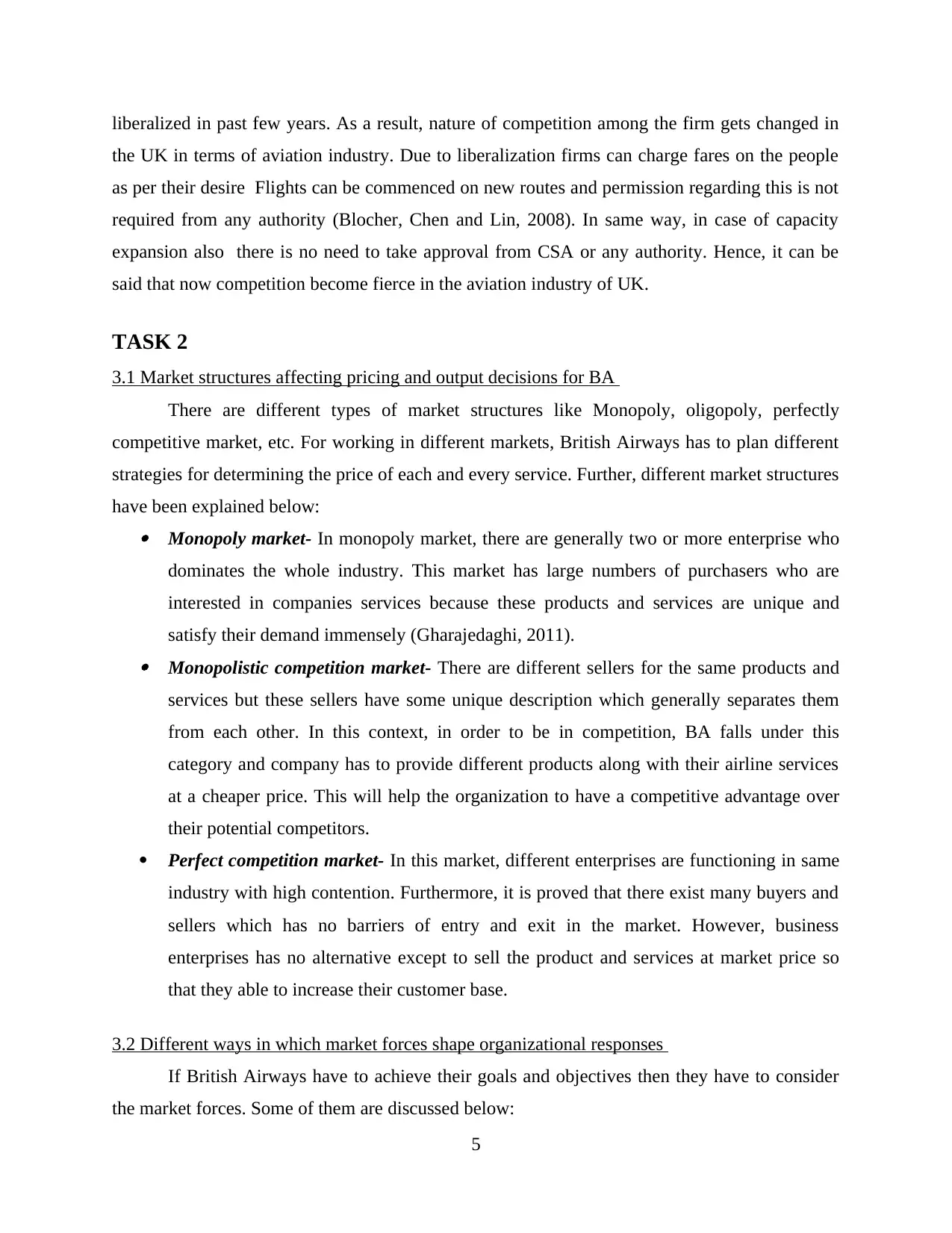
liberalized in past few years. As a result, nature of competition among the firm gets changed in
the UK in terms of aviation industry. Due to liberalization firms can charge fares on the people
as per their desire Flights can be commenced on new routes and permission regarding this is not
required from any authority (Blocher, Chen and Lin, 2008). In same way, in case of capacity
expansion also there is no need to take approval from CSA or any authority. Hence, it can be
said that now competition become fierce in the aviation industry of UK.
TASK 2
3.1 Market structures affecting pricing and output decisions for BA
There are different types of market structures like Monopoly, oligopoly, perfectly
competitive market, etc. For working in different markets, British Airways has to plan different
strategies for determining the price of each and every service. Further, different market structures
have been explained below: Monopoly market- In monopoly market, there are generally two or more enterprise who
dominates the whole industry. This market has large numbers of purchasers who are
interested in companies services because these products and services are unique and
satisfy their demand immensely (Gharajedaghi, 2011). Monopolistic competition market- There are different sellers for the same products and
services but these sellers have some unique description which generally separates them
from each other. In this context, in order to be in competition, BA falls under this
category and company has to provide different products along with their airline services
at a cheaper price. This will help the organization to have a competitive advantage over
their potential competitors.
Perfect competition market- In this market, different enterprises are functioning in same
industry with high contention. Furthermore, it is proved that there exist many buyers and
sellers which has no barriers of entry and exit in the market. However, business
enterprises has no alternative except to sell the product and services at market price so
that they able to increase their customer base.
3.2 Different ways in which market forces shape organizational responses
If British Airways have to achieve their goals and objectives then they have to consider
the market forces. Some of them are discussed below:
5
the UK in terms of aviation industry. Due to liberalization firms can charge fares on the people
as per their desire Flights can be commenced on new routes and permission regarding this is not
required from any authority (Blocher, Chen and Lin, 2008). In same way, in case of capacity
expansion also there is no need to take approval from CSA or any authority. Hence, it can be
said that now competition become fierce in the aviation industry of UK.
TASK 2
3.1 Market structures affecting pricing and output decisions for BA
There are different types of market structures like Monopoly, oligopoly, perfectly
competitive market, etc. For working in different markets, British Airways has to plan different
strategies for determining the price of each and every service. Further, different market structures
have been explained below: Monopoly market- In monopoly market, there are generally two or more enterprise who
dominates the whole industry. This market has large numbers of purchasers who are
interested in companies services because these products and services are unique and
satisfy their demand immensely (Gharajedaghi, 2011). Monopolistic competition market- There are different sellers for the same products and
services but these sellers have some unique description which generally separates them
from each other. In this context, in order to be in competition, BA falls under this
category and company has to provide different products along with their airline services
at a cheaper price. This will help the organization to have a competitive advantage over
their potential competitors.
Perfect competition market- In this market, different enterprises are functioning in same
industry with high contention. Furthermore, it is proved that there exist many buyers and
sellers which has no barriers of entry and exit in the market. However, business
enterprises has no alternative except to sell the product and services at market price so
that they able to increase their customer base.
3.2 Different ways in which market forces shape organizational responses
If British Airways have to achieve their goals and objectives then they have to consider
the market forces. Some of them are discussed below:
5
Paraphrase This Document
Need a fresh take? Get an instant paraphrase of this document with our AI Paraphraser
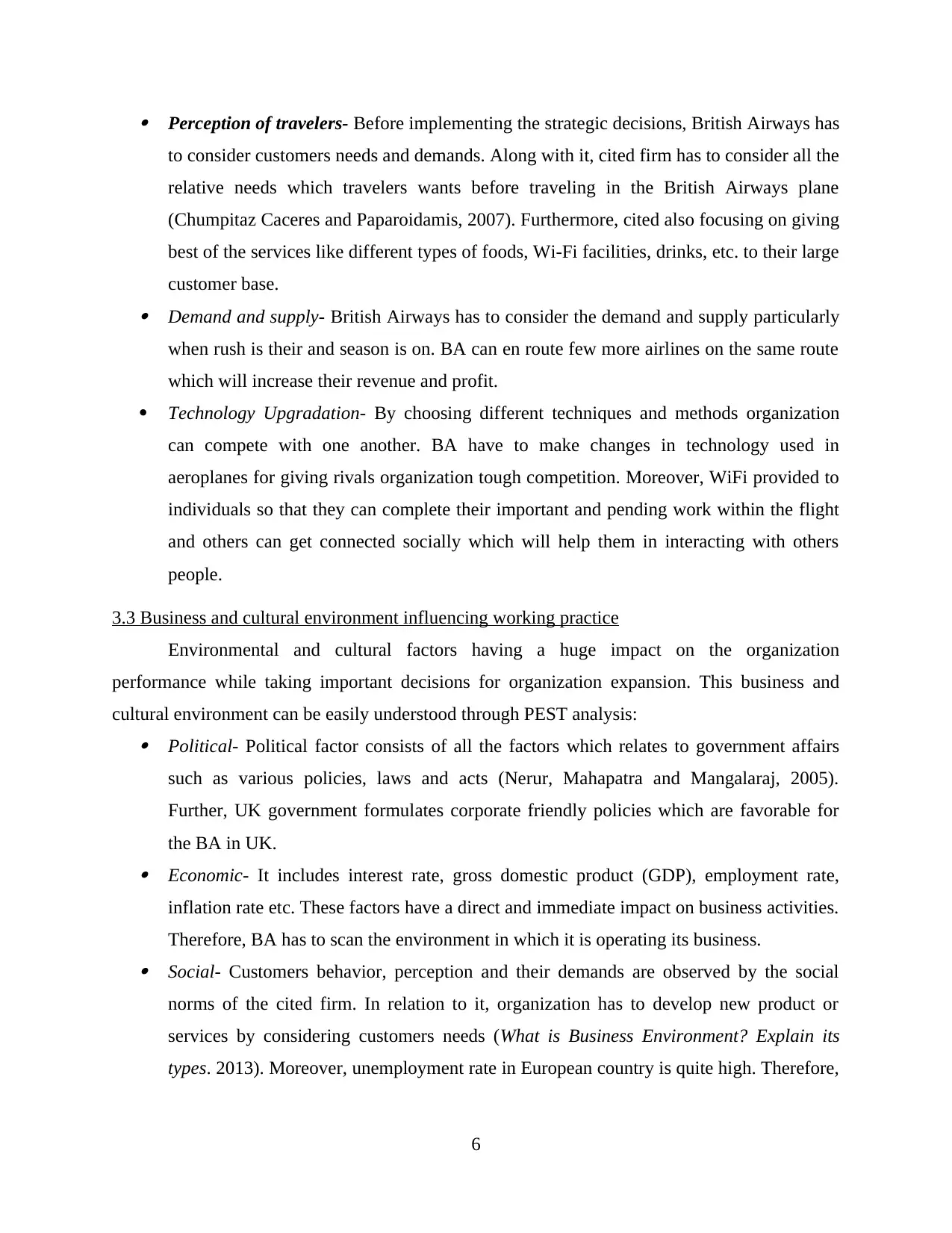
Perception of travelers- Before implementing the strategic decisions, British Airways has
to consider customers needs and demands. Along with it, cited firm has to consider all the
relative needs which travelers wants before traveling in the British Airways plane
(Chumpitaz Caceres and Paparoidamis, 2007). Furthermore, cited also focusing on giving
best of the services like different types of foods, Wi-Fi facilities, drinks, etc. to their large
customer base. Demand and supply- British Airways has to consider the demand and supply particularly
when rush is their and season is on. BA can en route few more airlines on the same route
which will increase their revenue and profit.
Technology Upgradation- By choosing different techniques and methods organization
can compete with one another. BA have to make changes in technology used in
aeroplanes for giving rivals organization tough competition. Moreover, WiFi provided to
individuals so that they can complete their important and pending work within the flight
and others can get connected socially which will help them in interacting with others
people.
3.3 Business and cultural environment influencing working practice
Environmental and cultural factors having a huge impact on the organization
performance while taking important decisions for organization expansion. This business and
cultural environment can be easily understood through PEST analysis: Political- Political factor consists of all the factors which relates to government affairs
such as various policies, laws and acts (Nerur, Mahapatra and Mangalaraj, 2005).
Further, UK government formulates corporate friendly policies which are favorable for
the BA in UK. Economic- It includes interest rate, gross domestic product (GDP), employment rate,
inflation rate etc. These factors have a direct and immediate impact on business activities.
Therefore, BA has to scan the environment in which it is operating its business. Social- Customers behavior, perception and their demands are observed by the social
norms of the cited firm. In relation to it, organization has to develop new product or
services by considering customers needs (What is Business Environment? Explain its
types. 2013). Moreover, unemployment rate in European country is quite high. Therefore,
6
to consider customers needs and demands. Along with it, cited firm has to consider all the
relative needs which travelers wants before traveling in the British Airways plane
(Chumpitaz Caceres and Paparoidamis, 2007). Furthermore, cited also focusing on giving
best of the services like different types of foods, Wi-Fi facilities, drinks, etc. to their large
customer base. Demand and supply- British Airways has to consider the demand and supply particularly
when rush is their and season is on. BA can en route few more airlines on the same route
which will increase their revenue and profit.
Technology Upgradation- By choosing different techniques and methods organization
can compete with one another. BA have to make changes in technology used in
aeroplanes for giving rivals organization tough competition. Moreover, WiFi provided to
individuals so that they can complete their important and pending work within the flight
and others can get connected socially which will help them in interacting with others
people.
3.3 Business and cultural environment influencing working practice
Environmental and cultural factors having a huge impact on the organization
performance while taking important decisions for organization expansion. This business and
cultural environment can be easily understood through PEST analysis: Political- Political factor consists of all the factors which relates to government affairs
such as various policies, laws and acts (Nerur, Mahapatra and Mangalaraj, 2005).
Further, UK government formulates corporate friendly policies which are favorable for
the BA in UK. Economic- It includes interest rate, gross domestic product (GDP), employment rate,
inflation rate etc. These factors have a direct and immediate impact on business activities.
Therefore, BA has to scan the environment in which it is operating its business. Social- Customers behavior, perception and their demands are observed by the social
norms of the cited firm. In relation to it, organization has to develop new product or
services by considering customers needs (What is Business Environment? Explain its
types. 2013). Moreover, unemployment rate in European country is quite high. Therefore,
6

customers might avoid vising new places which may become a major drawback for
British Airways.
Technological- With new innovations, technology is changing with a rapid pace, cited
organization have to make some adjustment in their operational activities (Rugman, A.M.
and Collinson, 2009). British Airways has to focus on improving the product quality with
decrease in cost of services and product.
4.1 Significance of international trade to British Airways
International trade has expanded in recent times because of new production techniques
and better transportation system. With rise of international trade, BA has expanded their business
activities with no or little barriers, It is giving lot of benefit to mention company as cultural
relations are also developing between two or more countries. With recent development, business
is focusing on starting cargo segment which will provide transportation of goods facilities from
one country to another (Malhotra, 2005). If there had been no international trade in UK then
corporate could not have generated this much of profit and revenue. With the rise of international
trade, corporate is carrying 36 million passengers from worldwide annually and runs 750 daily
flights. Further, for drafting a new policy, UK Treasury department has to evaluate some
advantage and disadvantage of the same:
Advantages:
International trade help country to have best use of all the available resources. Further,
BA need to develop only those services which are best suited for the travelers who are
living in different country. Foreign trade leading to encourage the production of different types of goods and
services for different countries. Further, BA serves products and services at low rate
because of division of the labor in specific country.
Disadvantages
International trade having a bad effect on development of home country as it poses a
threat for the survival of small industries due to foreign competitors coming (Osterwalder
and Pigneur, 2010).
Underdeveloped countries are relying on the developed ones for their economic as well
as overall development.
7
British Airways.
Technological- With new innovations, technology is changing with a rapid pace, cited
organization have to make some adjustment in their operational activities (Rugman, A.M.
and Collinson, 2009). British Airways has to focus on improving the product quality with
decrease in cost of services and product.
4.1 Significance of international trade to British Airways
International trade has expanded in recent times because of new production techniques
and better transportation system. With rise of international trade, BA has expanded their business
activities with no or little barriers, It is giving lot of benefit to mention company as cultural
relations are also developing between two or more countries. With recent development, business
is focusing on starting cargo segment which will provide transportation of goods facilities from
one country to another (Malhotra, 2005). If there had been no international trade in UK then
corporate could not have generated this much of profit and revenue. With the rise of international
trade, corporate is carrying 36 million passengers from worldwide annually and runs 750 daily
flights. Further, for drafting a new policy, UK Treasury department has to evaluate some
advantage and disadvantage of the same:
Advantages:
International trade help country to have best use of all the available resources. Further,
BA need to develop only those services which are best suited for the travelers who are
living in different country. Foreign trade leading to encourage the production of different types of goods and
services for different countries. Further, BA serves products and services at low rate
because of division of the labor in specific country.
Disadvantages
International trade having a bad effect on development of home country as it poses a
threat for the survival of small industries due to foreign competitors coming (Osterwalder
and Pigneur, 2010).
Underdeveloped countries are relying on the developed ones for their economic as well
as overall development.
7
⊘ This is a preview!⊘
Do you want full access?
Subscribe today to unlock all pages.

Trusted by 1+ million students worldwide

4.2 Impact of global factors on BA
Some global factors affect the performance of BA and few have been explained below: Business environment- BA has to realize the business environment of different countries
for improving their efficiency as well as effectiveness. Further, before starting the new
operation in some countries, BA has to undertake PEST and SWOT analysis to analyze
the external environment. Exchange rates- BA revenue is majorly affected by the exchange rates. Therefore, sudden
change in exchange rate of UK as compared with other countries can become a crucial
drawback for cited organization (Salzmann, Ionescu-Somers and Steger, 2005).
International competition- British Airways generally getting tough competition from
their major competitors like Deutsche Lufthansa AG, Japan Airlines Co. Ltd, Jet
Airways, etc. However, if competitors started increasing at the same rate then it can
affect the performance of organization.
4.3 Impact of policies of European Union on UK business organizations
UK business is highly influenced by European Union. It is a group of all the European
countries which actively participate in the world economy. Following are the factors which are
affected by European Union:
Taxation policies: Organizations which operate business can contribute to the community by
paying their taxes on time. With this, government can help the industries in various projects like
developing roads, airports, etc.
Inflation policies: With the use of Monitory Policy Committee which sets interest rates. The
government makes sure that there is no increase in prices (Our Strategies and Objectives. 2010).
When individuals spends or borrow money in huge amount, then this leads to increase in rates of
interest. As a result it becomes difficult for the individuals to borrow. Thus, they spend less
which helps in reducing the prices.
Education and Training policies: Education and training policies has done a valuable
contribution in developing business. UK government plays a major role by providing education
and training. With education, the knowledge regarding various areas increases and this leads in
the innovation of new ideas.
8
Some global factors affect the performance of BA and few have been explained below: Business environment- BA has to realize the business environment of different countries
for improving their efficiency as well as effectiveness. Further, before starting the new
operation in some countries, BA has to undertake PEST and SWOT analysis to analyze
the external environment. Exchange rates- BA revenue is majorly affected by the exchange rates. Therefore, sudden
change in exchange rate of UK as compared with other countries can become a crucial
drawback for cited organization (Salzmann, Ionescu-Somers and Steger, 2005).
International competition- British Airways generally getting tough competition from
their major competitors like Deutsche Lufthansa AG, Japan Airlines Co. Ltd, Jet
Airways, etc. However, if competitors started increasing at the same rate then it can
affect the performance of organization.
4.3 Impact of policies of European Union on UK business organizations
UK business is highly influenced by European Union. It is a group of all the European
countries which actively participate in the world economy. Following are the factors which are
affected by European Union:
Taxation policies: Organizations which operate business can contribute to the community by
paying their taxes on time. With this, government can help the industries in various projects like
developing roads, airports, etc.
Inflation policies: With the use of Monitory Policy Committee which sets interest rates. The
government makes sure that there is no increase in prices (Our Strategies and Objectives. 2010).
When individuals spends or borrow money in huge amount, then this leads to increase in rates of
interest. As a result it becomes difficult for the individuals to borrow. Thus, they spend less
which helps in reducing the prices.
Education and Training policies: Education and training policies has done a valuable
contribution in developing business. UK government plays a major role by providing education
and training. With education, the knowledge regarding various areas increases and this leads in
the innovation of new ideas.
8
Paraphrase This Document
Need a fresh take? Get an instant paraphrase of this document with our AI Paraphraser
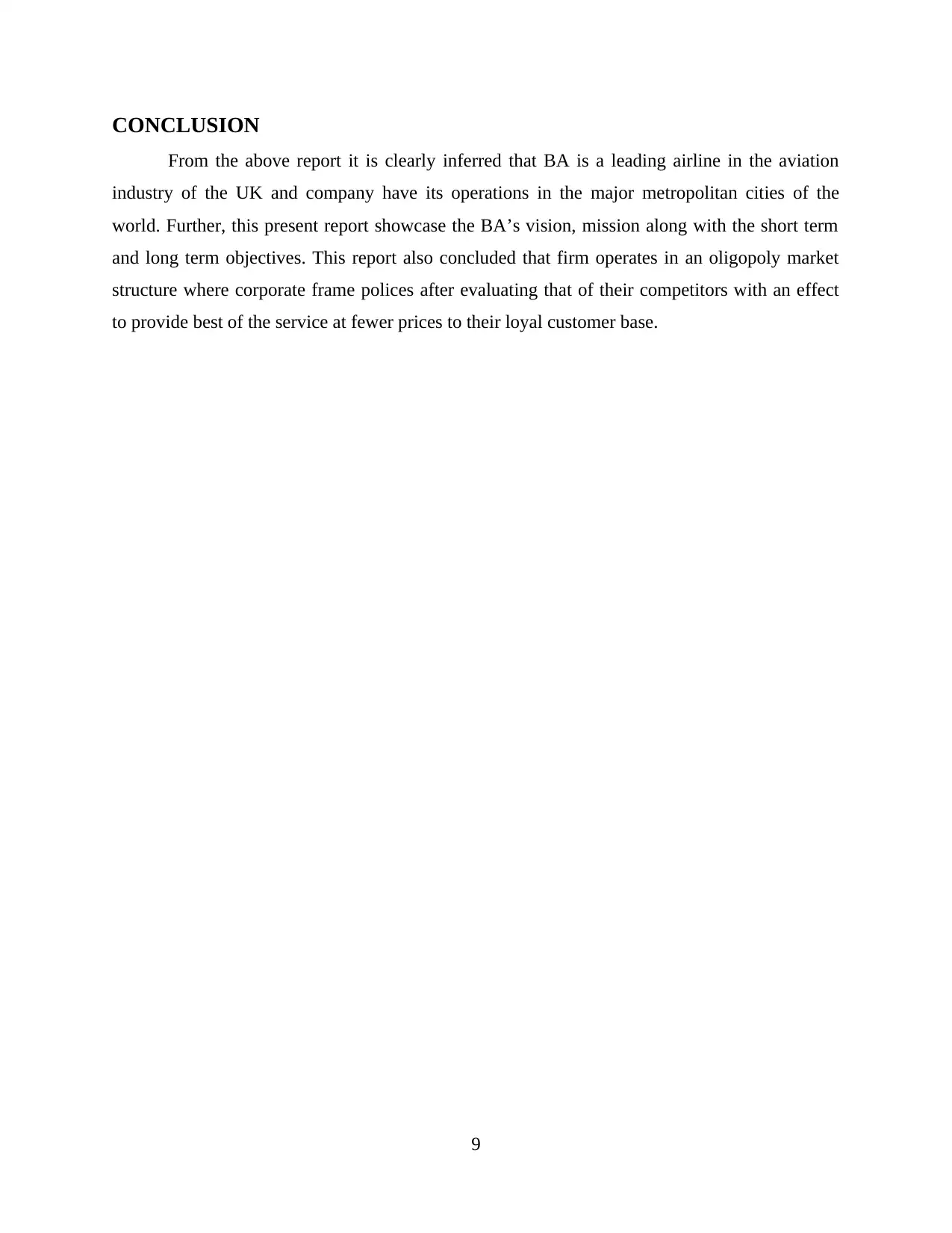
CONCLUSION
From the above report it is clearly inferred that BA is a leading airline in the aviation
industry of the UK and company have its operations in the major metropolitan cities of the
world. Further, this present report showcase the BA’s vision, mission along with the short term
and long term objectives. This report also concluded that firm operates in an oligopoly market
structure where corporate frame polices after evaluating that of their competitors with an effect
to provide best of the service at fewer prices to their loyal customer base.
9
From the above report it is clearly inferred that BA is a leading airline in the aviation
industry of the UK and company have its operations in the major metropolitan cities of the
world. Further, this present report showcase the BA’s vision, mission along with the short term
and long term objectives. This report also concluded that firm operates in an oligopoly market
structure where corporate frame polices after evaluating that of their competitors with an effect
to provide best of the service at fewer prices to their loyal customer base.
9
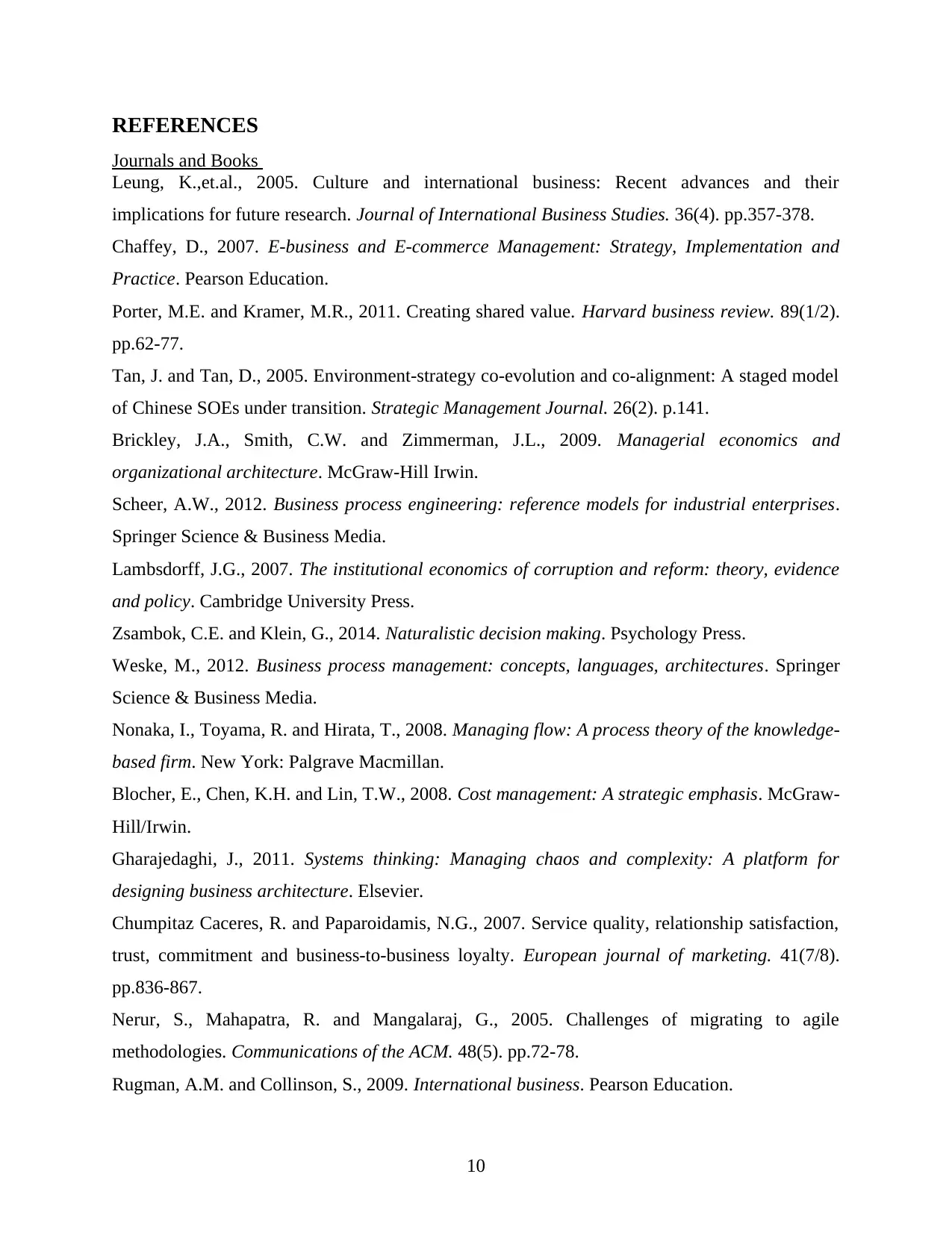
REFERENCES
Journals and Books
Leung, K.,et.al., 2005. Culture and international business: Recent advances and their
implications for future research. Journal of International Business Studies. 36(4). pp.357-378.
Chaffey, D., 2007. E-business and E-commerce Management: Strategy, Implementation and
Practice. Pearson Education.
Porter, M.E. and Kramer, M.R., 2011. Creating shared value. Harvard business review. 89(1/2).
pp.62-77.
Tan, J. and Tan, D., 2005. Environment-strategy co-evolution and co-alignment: A staged model
of Chinese SOEs under transition. Strategic Management Journal. 26(2). p.141.
Brickley, J.A., Smith, C.W. and Zimmerman, J.L., 2009. Managerial economics and
organizational architecture. McGraw-Hill Irwin.
Scheer, A.W., 2012. Business process engineering: reference models for industrial enterprises.
Springer Science & Business Media.
Lambsdorff, J.G., 2007. The institutional economics of corruption and reform: theory, evidence
and policy. Cambridge University Press.
Zsambok, C.E. and Klein, G., 2014. Naturalistic decision making. Psychology Press.
Weske, M., 2012. Business process management: concepts, languages, architectures. Springer
Science & Business Media.
Nonaka, I., Toyama, R. and Hirata, T., 2008. Managing flow: A process theory of the knowledge-
based firm. New York: Palgrave Macmillan.
Blocher, E., Chen, K.H. and Lin, T.W., 2008. Cost management: A strategic emphasis. McGraw-
Hill/Irwin.
Gharajedaghi, J., 2011. Systems thinking: Managing chaos and complexity: A platform for
designing business architecture. Elsevier.
Chumpitaz Caceres, R. and Paparoidamis, N.G., 2007. Service quality, relationship satisfaction,
trust, commitment and business-to-business loyalty. European journal of marketing. 41(7/8).
pp.836-867.
Nerur, S., Mahapatra, R. and Mangalaraj, G., 2005. Challenges of migrating to agile
methodologies. Communications of the ACM. 48(5). pp.72-78.
Rugman, A.M. and Collinson, S., 2009. International business. Pearson Education.
10
Journals and Books
Leung, K.,et.al., 2005. Culture and international business: Recent advances and their
implications for future research. Journal of International Business Studies. 36(4). pp.357-378.
Chaffey, D., 2007. E-business and E-commerce Management: Strategy, Implementation and
Practice. Pearson Education.
Porter, M.E. and Kramer, M.R., 2011. Creating shared value. Harvard business review. 89(1/2).
pp.62-77.
Tan, J. and Tan, D., 2005. Environment-strategy co-evolution and co-alignment: A staged model
of Chinese SOEs under transition. Strategic Management Journal. 26(2). p.141.
Brickley, J.A., Smith, C.W. and Zimmerman, J.L., 2009. Managerial economics and
organizational architecture. McGraw-Hill Irwin.
Scheer, A.W., 2012. Business process engineering: reference models for industrial enterprises.
Springer Science & Business Media.
Lambsdorff, J.G., 2007. The institutional economics of corruption and reform: theory, evidence
and policy. Cambridge University Press.
Zsambok, C.E. and Klein, G., 2014. Naturalistic decision making. Psychology Press.
Weske, M., 2012. Business process management: concepts, languages, architectures. Springer
Science & Business Media.
Nonaka, I., Toyama, R. and Hirata, T., 2008. Managing flow: A process theory of the knowledge-
based firm. New York: Palgrave Macmillan.
Blocher, E., Chen, K.H. and Lin, T.W., 2008. Cost management: A strategic emphasis. McGraw-
Hill/Irwin.
Gharajedaghi, J., 2011. Systems thinking: Managing chaos and complexity: A platform for
designing business architecture. Elsevier.
Chumpitaz Caceres, R. and Paparoidamis, N.G., 2007. Service quality, relationship satisfaction,
trust, commitment and business-to-business loyalty. European journal of marketing. 41(7/8).
pp.836-867.
Nerur, S., Mahapatra, R. and Mangalaraj, G., 2005. Challenges of migrating to agile
methodologies. Communications of the ACM. 48(5). pp.72-78.
Rugman, A.M. and Collinson, S., 2009. International business. Pearson Education.
10
⊘ This is a preview!⊘
Do you want full access?
Subscribe today to unlock all pages.

Trusted by 1+ million students worldwide
1 out of 13
Related Documents
Your All-in-One AI-Powered Toolkit for Academic Success.
+13062052269
info@desklib.com
Available 24*7 on WhatsApp / Email
![[object Object]](/_next/static/media/star-bottom.7253800d.svg)
Unlock your academic potential
Copyright © 2020–2025 A2Z Services. All Rights Reserved. Developed and managed by ZUCOL.





